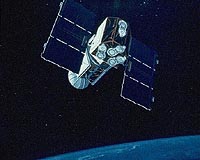 |
USAF Academy CO (SPX) May 19, 2011 Academy Astronautics cadets and the Space Systems Research Center successfully completed its static fire of the FalconLaunch-T1 rocket motor on Monday in Jack's Valley. The motor burned for approximately 1.5 seconds and reached combustion chamber pressures of nearly 1,500 PSI. The purpose of the test was to evaluate the propulsion system being designed for the rocket scheduled for launch in April 2012. Specifically, the test confirmed the propulsion system's structural integrity and readiness for launch. The test also aimed to validate theoretical thrust, burn time, and chamber pressure calculations made by the cadets. Post-test quick-look data analysis indicated nominal performance, but further detailed analysis will continue over the next few weeks, conducted by cadets, faculty, and staff. The motor segment was provided by Vulcan Systems of Penrose, Colo., while the rocket nozzle, casing, and other components were designed and manufactured by cadets, faculty, and staff at USAFA. "The cadets and faculty were really pleased to have the Dean drop by for the test--as well as Scott Dixon and Daron Bromaghim from the Air Force Research Laboratory," said Col. Martin France, permanent professor and head of the Astronautics Department. "After all of the hard work that they and Mr. Dixon have put in this year, it's great to not only see the test go so well, but all see that we have so many supporters who care deeply about the valuable experiences the course provides these cadets." This year's test also included additional rocket subsystems never before tested in previous FalconLAUNCH static fires, including the avionics and ground station subsystems. These systems performed well during the test, while integration procedures for subsystems were also exercised/evaluated. This test rocket is a precursor to the larger FalconLAUNCH-9 vehicle being developed in the Space Systems Research Center to reliably launch Department of Defense payloads on high-altitude, suborbital missions to space. The focus on this year's program has been on reliability and design of new avionics and recovery systems to facilitate future robust testing. After one or more additional static firings and component level testing, the next launch of a cadet built rocket should be in Spring 2012. The FalconLAUNCH program is sponsored by the Air Force Research Laboratory's Propulsion Directorate at Edwards AFB, Calif., and also benefits from the support of the USAFA Endowment.
Share This Article With Planet Earth
Related Links - Launch Pad at Space-Travel.com
 GSAT-8 put through its paces
GSAT-8 put through its pacesKourou, French Guiana (SPX) Apr 26, 2011 The Indian GSAT-8 multi-role spacecraft for Arianespace's next Ariane 5 mission is undergoing an in-depth checkout at the Spaceport in French Guiana in preparation for its liftoff on May 19. GSAT-8 was built by the Indian Space Research Organisation (ISRO) using its I-3K satellite bus, and validations being performed in the Spaceport's S5 payload preparation facility include antenna and so ... read more |
|
| The content herein, unless otherwise known to be public domain, are Copyright 1995-2010 - SpaceDaily. AFP and UPI Wire Stories are copyright Agence France-Presse and United Press International. ESA Portal Reports are copyright European Space Agency. All NASA sourced material is public domain. Additional copyrights may apply in whole or part to other bona fide parties. Advertising does not imply endorsement,agreement or approval of any opinions, statements or information provided by SpaceDaily on any Web page published or hosted by SpaceDaily. Privacy Statement |